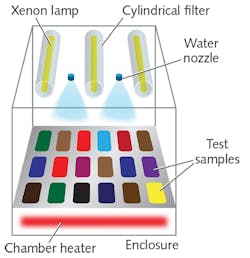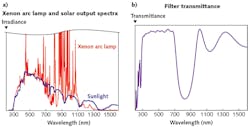Novel sputtering technology improves optical coatings for solar simulation
DAVID FAVOT
The effect of outdoor exposure, particularly to sunlight and rain, is of concern for a wide variety of products. Typical examples include automobiles (exterior finishes, paints, upholstery, plastics, trims), fabrics (clothing, carpeting, wall coverings, outdoor furniture), building materials (lumber, roofing), architectural coatings (paints, vinyl siding), toys, bicycles, and camping equipment, to name just a few. However, simply exposing a sample product to the elements isn’t a practical testing methodology, since the exact exposure conditions cannot be controlled and the process cannot be accelerated. This article reviews the technology presently in use for performing accelerated weathering, with an emphasis on the use of a novel thin-film coating technique to deliver a light source that closely matches the solar spectrum—this is a key component in accurate environmental testing.
Weathering chamber basics
The three major factors in weathering are sunlight, moisture (in the form of both humidity and rain), and temperature. Simulating outdoor exposure therefore requires reproducing all these conditions with accuracy, repeatability, and reproducibility. This enables a manufacturer to test and compare various trial product formulations under identical conditions.
A schematic of a typical weathering test chamber shows how this is sometimes implemented in practice (see Fig. 1). A stainless-steel chamber incorporates one or more high-intensity xenon arc lamps, as well as racks for holding test samples. Water nozzles are used to produce “rain.” Additionally, atomized water can be introduced into the chamber to achieve a wide range of humidity levels. Besides controlling chamber air temperature, many systems can also independently vary the so-called “black panel” temperature, which is the temperature of the surface on which the parts sit.
In operation, air temperature, sample temperature, humidity, black panel temperature, and part irradiance can be held constant or varied to simulate different latitudes, different seasons, and different weather patterns. This technology also enables acceleration of the weathering process, enabling long-term durability to be measured.
Accelerated testing is accomplished through two means. First, the percentage of time a part is exposed to sunlight during a 24-hour period can be increased (up to 100%). In the real world, even during daylight hours, the changing angle of the sun alters the level of exposure experienced out in the open. Thus, maintaining a noontime light level over an entire day of testing results in far more than a 2X increase in exposure. The second method of producing acceleration is to use light levels that are greater than “one sun.” This can also be accompanied by higher air temperature and humidity.
Accurate solar simulation
In order for laboratory weathering to accurately simulate the effects of real-world exposure, the output spectrum of the light source must closely match the solar spectrum. The xenon arc lamp source approximates solar radiation quite well at visible wavelengths—however, its output does contain some intense spectral lines in the infrared (IR). The IR spikes become particularly problematic during accelerated testing (greater than one-sun exposure levels) because they produce excessive product heating.
Historically, absorptive glass filters have been the solution for eliminating the unwanted IR portions of the xenon arc lamp spectrum. However, these absorption filters are notoriously unstable, which challenges efforts to achieve repeatability and reproducibility. Thin-film coatings are inherently more stable and can also be designed to block the IR spikes in the xenon output more precisely.
Unfortunately, evaporation, which is the most widely used thin-film coating technology, has some important drawbacks in the context of fabricating filters for environmental testing. In particular, evaporative films are relatively porous, which allows the coating to absorb water. This, in turn, changes the effective refractive index of the film layers, leading to a humidity-dependent shift in its spectral characteristics. Porosity also negatively impacts the hardness, heat resistance, and mechanical durability of the resultant film.
Evaporation produces porous films because of the relatively low energy with which atoms or molecules are ejected from the material source. As a result, they deposit onto the target substrate, leaving relatively large interstitial spaces. This can be improved somewhat by using ion-assisted deposition (IAD), in which the ions, which are accelerated by an electric field, act as “hammers” to pound the coating molecules and increase density. But achieving a major step up in film density requires moving to a more-energetic deposition process such as sputtering.
Sputtering is conducted in a chamber filled with a low-pressure inert gas. Targets of various conductive coating materials are placed around the periphery of this chamber. A high voltage is applied to the targets, ionizing the gas around them to form a plasma. These ions are then accelerated by the electric field into the target, causing atoms to sputter off. The sputtered atoms fill the chamber and some are deposited on the surface of the optics. The high energy of the sputtered atoms produces coatings that are inherently denser than achieved through evaporation, and therefore less subject to water absorption.If oxygen is introduced into the machine during sputtering, it will react with the material atoms to produce oxides. This process, called reactive sputtering, yields coatings with even better mechanical and thermal characteristics. Deposition Sciences Inc. (DSI; Santa Rosa, CA) has developed a unique approach to reactive sputtering, called the MicroDyn process, in which sputtering is augmented by a microwave plasma that forms a wider range of oxygen species (ozone, etc.) to enhance the reaction process (see Fig. 2). The net result is faster, more efficient deposition with greater control and variation of deposited material refractive index.
Using the MicroDyn sputtering process, it is possible to produce filters that supply the necessary spectral characteristics for solar simulation while delivering sufficient mechanical density to withstand prolonged exposure to water, heat, and high flux levels. Specifically, a multilayer hot-mirror coating (which passes visible light and reflects IR) is used. This coating provides high transmittance from 300 nm through the visible region and then attenuates in the near-IR (see Fig. 3).Coating tubes
Because the xenon source is a long, thin tube, one approach to filtering the light is to surround the lamp with a coated cylindrical substrate. This keeps the angle of incidence of light from the lamp at near normal at all points. This is important because the transmission characteristics of all thin film coatings shift with angle, so high angles of incidence alter coating performance. This arrangement also allows parts to be placed all around (360°) the source for chambers in which the lamp is mounted at the center of a rotating rack, rather than at the side of the enclosure.
In some systems, water may flow over the coated filter for cooling purposes. Thus, a thin film coating for this application must be deposited on a small radius tube and also be capable of surviving both high flux levels and direct exposure to the continual flow of corrosive cooling water. Again, the high density of a sputtered coating enables it to deliver on all these fronts.
However, producing a uniform coating around the entire outside circumference of a highly curved tube is problematic for most thin-film deposition techniques. This is because the relatively long mean free path of the coating material molecules causes deposition to occur in a line of sight to the material source. When coating an object like a cylinder, the result is that only the half facing the sputtering targets will be coated, and the coating thickness will vary substantially across the part (see Fig. 4). The latter causes an unwanted spatial variation in the optical performance of the coating.Engineers at DSI have developed customized tooling for their reactive sputtering system specifically to address this problem and produce a uniform coating around the entire circumference of the cylinder. In particular, each tube is held by its end on a rod, which itself rotates during the coating process. This rotation is synchronized with the motion of the chamber’s rotating drum and the timing of the sputtering process itself. This allows every part of the tube’s outer surface to be exposed during the coating process for an equal amount of time.
Laboratory weathering enables manufacturers in a broad range of industries to improve their products’ durability and lifetime. More accurate and long-lasting coatings enable improved solar simulation, directly benefiting this application. Furthermore, this same technology can be applied to many other areas requiring uniform coating of cylindrical parts.
David Favot is business development manager at Deposition Sciences, Inc., Santa Rosa, CA; e-mail: [email protected]; www.depsci.com.



